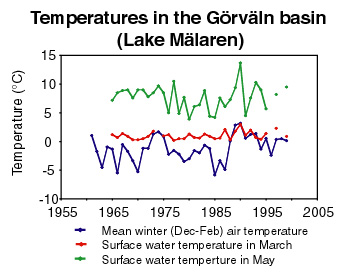 |
||
|
Impacts of warmer winters on lake water temperatures |
||
| 1. Impacts on surface water temperatures Surface lake water temperatures respond immediately to changes in air temperature provided that lakes are not ice covered. Whenever lakes are ice covered, we observe primarily a change in the thickness of the ice cover and not in the water temperature as a response to an increase in air temperature. First when the lake ice has disappeared water temperatures immediately reflect changes in the air temperature. Sweden's largest lakes Vänern, Vättern and Mälaren are usually icefree in May. Consequently extreme warm air temperatures such as during the winter 1989/90 caused May surface water temperatures to become exceptionally warm as seen in Lake Mälaren (see green line in figure). Comparing a relatively cold period in Sweden, 1982 to 1988, with the warm period 1989 to 1995, surface water temperatures in May in Sweden's largest lakes increased by 0.6 to 4.7 °C1. Since water temperature determines many biogeochemical processes in lakes even a small increase in water temperatures might change the water quality. In northwestern Ontario in Canada it was found that both air and lake temperatures increased by about 2°C from 1970-19902. This change was related to a change of observed chemical and biological changes in the area. 2. Impacts on bottom water temperatures Like surface water temperatures also bottom water temperatures are determined by air temperatures but here the relationship is more complex, and depending on lake morphometry (lake size and lake depth) air temperature signals are differently pronounced3. In May when Sweden's largest lakes are icefree and the water column is mixed we see a clear winter mean air temperature signal on bottom water temperatures. The signal declines when the lake water starts to stratify into a warm epilimnion and a cold hypolimnion. But even if the signal declines, large scale climatic processes still have an impact on bottom water temperatures as seen by a relationship between hypolimnetic temperatures in Lake Vänern and Vättern and the total solar irradiance4. |
1 Weyhenmeyer, G. A. 2001. Warmer winters: are planktonic algal populations in Sweden's largest lakes affected? Ambio 30: 565-571. 2 Schindler, D. W., Beaty, K. G., Fee, E. J., Cruikshank, D. R., DeBruyn, E. R. et al. 1990. Effects of climatic warming on lakes of the central boreal forest. Science 250: 967-970. 3 Livingstone, D. M. 1997. An example of the simultaneous occurrence of climate-driven "sawtooth" deep-water warming/cooling episodes in several Swiss lakes. Verh. Internat. Verein. Limnol. 26: 822-828. 4 Goedkoop, W. and Johnson R. K. 2001. Factors affecting population fluctuations of the glacial relict amphipod Monoporeia affinis (Lindström) in Sweden's largest lakes. Ambio 30: 552-558. Further reading Gerten, D. and Adrian, R. 2001. Differences in the persistency of the North Atlantic Oscillation signal among lakes. Limnol. Oceanogr. 46: 448-455. Gerten, D. and Adrian, R. 2002. Effects of climate warming, North Atlantic Oscillation, and El Nino-Southern Oscillation on thermal conditions and plankton dynamics in northern hemispheric lakes. The Scientific World 2: 586-606. Livingstone, D.M. and Dokulil, M. T. 2001. Eighty years of spatially coherent Austrian lake surface temperatures and their relationship to regional air temperatures and to the North Atlantic Oscillation. Limnol. Oceanogr. 46: 1220-1227.
|
|
